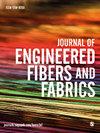A study on mechanical properties and thermal properties of UHMWPE/MWCNT composite fiber with MWCNT content and draw ratio
IF 2.3
4区 工程技术
Q1 MATERIALS SCIENCE, TEXTILES
引用次数: 1
Abstract
In this study, the mechanical properties and thermal properties of ultra-high molecular weight polyethylene (UHMWPE)/multi wall carbon nanotubes (MWCNT) composite fiber were investigated with different weight percent of the MWCNT contents and draw ratio. To verified the thermal properties of the MWCNT/UHMWPE composite fiber, DSC and TGA analysis were performed. The addition of MWCNT and the higher draw ratio improved the thermal properties of the UHMWPE composite fiber by improving the crystallinity of the polymer. By adding 2 wt% MWCNT, UHWMPE fibers with tensile strengths of 3.85 GPa and young’s modulus of 27.43 GPa could fabricated. In comparison with the pristine UHMWPE fiber with same draw ratio conditions, there values shows increases of 21% in tensile strength and 16% in young’s modulus value. However, in the case of the specimens in which the MWCNT content of 6wt% and 10wt% was added to the UHMWPE fiber, the tensile strength and tensile modulus gradually decreased. We proved by experimentally that the mechanism of strengthening the tensile strength of UHMWPE fibers with MWCNT content of 2wt% is to block craze stretching and reduce defects inside the amorphous region by improving the crystalline region. However, the MWCNT contents is increased by 6wt% or more, the nanofillers start to agglomerate and act as impurities and stress concentration factors, thereby reducing the mechanical properties of the UHMWPE composite fiber.MWCNT含量和拉伸比对UHMWPE/MWCNT复合纤维力学性能和热性能的影响
研究了超高分子量聚乙烯(UHMWPE)/多壁碳纳米管(MWCNT)复合纤维在不同重量百分比和拉伸比下的力学性能和热性能。为了验证MWCNT/UHMWPE复合纤维的热性能,进行了DSC和TGA分析。MWCNT的加入和较高的拉伸比通过提高聚合物的结晶度来改善UHMWPE复合纤维的热性能。通过添加2wt%的MWCNT,UHWMPE纤维的拉伸强度为3.85 GPa和杨氏模量为27.43 GPa是可以制造的。与相同拉伸比条件下的原始UHMWPE纤维相比,拉伸强度增加了21%,杨氏模量增加了16%。然而,在向UHMWPE纤维中添加6wt%和10wt%的MWCNT含量的试样的情况下,拉伸强度和拉伸模量逐渐降低。实验证明,提高MWCNT含量为2wt%的UHMWPE纤维抗拉强度的机理是通过改善结晶区来阻断银纹拉伸,减少非晶区内的缺陷。然而,MWCNT含量增加6wt%或更多,纳米填料开始聚集并作为杂质和应力集中因子,从而降低UHMWPE复合纤维的机械性能。
本文章由计算机程序翻译,如有差异,请以英文原文为准。
求助全文
约1分钟内获得全文
求助全文
来源期刊

Journal of Engineered Fibers and Fabrics
工程技术-材料科学:纺织
CiteScore
5.00
自引率
6.90%
发文量
41
审稿时长
4 months
期刊介绍:
Journal of Engineered Fibers and Fabrics is a peer-reviewed, open access journal which aims to facilitate the rapid and wide dissemination of research in the engineering of textiles, clothing and fiber based structures.
 求助内容:
求助内容: 应助结果提醒方式:
应助结果提醒方式:


